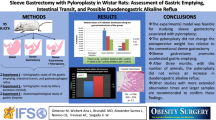Abstract
The aim was to determine whether pyloroplasty decreases the strength of pyloric contractions and speeds gastric emptying of solids, while subsequent pyloric reconstruction restores these abnormalities to the control. In conscious dogs, pyloroplasty decreased the strength of pyloroduodenal pressure waves measured with a perfused sleeve sensor [mean ± SEM pyloroduodenal motility index: control (N=7)=1116±351 mm Hg×sec/10 min; pyloroplasty (N=7)=43±19 mm Hg×sec/10 min;P<0.05], and caused rapid gastric emptying of solids measured scintigraphically (mean±SEM half-emptying time: control=246±14 min, pyloroplasty=176±16 min;P<0.05). The frequencies of pyloroduodenal waves and gastric emptying of liquids, however, were unchanged. Pyloric reconstruction restored the postpyloroplasty patterns to the control. In conclusion, pyloroplasty decreased the strength of pyloroduodenal contractions and sped gastric emptying of solids, while pyloric reconstruction restored the altered patterns to the control.
Similar content being viewed by others
References
Meyer JH, Thomson JB, Cohen MB, Shadchehr A, Mandiola SA: Sieving of solid food by the canine stomach and sieving after gastric surgery. Gastroenterology 76:804–813, 1979
Humphrey CS, Johnston D, Walker BE, Pulvertaft CN, Goligher JC: Incidence of dumping after truncal and selective vagotomy with pyloroplasty and highly selective vagotomy without drainage procedure. Br Med J 3:785–788, 1972
Cheadle WG, Baker PR, Cuschieri A: Pyloric reconstruction for severe vasomotor dumping after vagotomy and pyloroplasty. Ann Surg 202:568–572, 1985
Ebied FH, Ralphs DNL, Hobsley M, LeQuesne LP: Dumping symptoms after vagotomy treated by reversal of pyloroplasty. Br J Surg 69:527–528, 1982
Christiansen PM, Hansen OH, Pedersen T: Reconstruction of the pylorus for postvagotomy diarrhoea and dumping. Br J Surg 61:519–520, 1974
Frederiksen H-JB, Stacher Johansen T, Christiansen PM: Postvagotomy diarrhoea and dumping treated with reconstruction of the pylorus. Scand J Gastroenterol 15:245–248, 1980
Elashoff JD, Reedy TJ, Meyer JH: Analysis of gastric emptying data. Gastroenterology 83:1306–1312, 1982
Heddle R, Miedema BW, Kelly KA: Integration of canine proximal gastric, antral, pyloric and proximal duodenal motility during fasting and after a liquid meal. Dig Dis Sci 38:856–869, 1993
Heddle R, Dent J, Read NW, Houghton LA, Toouli J, Horowitz M, Maddern GJ, Downton J: Antropyloroduodenal motor responses to intraduodenal lipid infusion in healthy volunteers. Am J Physiol 254:G671-G679, 1988
Heddle R, Fone D, Dent J, Horowitz M: Stimulation of pyloric motility by intraduodenal dextrose in normal subjects. Gut 29:1349–1357, 1988
Brink BM, Schlegel JF, Code CF: The pressure profile of the gastroduodenal junctional zone in dogs. Gut 6:163–171, 1965
Valenzuela JE, Defilippi C, Csendes A: Manometric studies on the human pyloric sphineter. Effect of eigarette smoking, metoclopramide and atropine. Gastroenterology 70:481–483, 1976
Allescher HD, Daniel EE, Dent J, Fox JE, Kostolanska F: Extrinsic and intrinsic neural control of pyloric sphineter pressure in the dog. J Physiol (London) 401:17–38, 1988
Anvari M, Myers J, Horowitz M, Dent J, Jamieson GG: Pattern of antropyloroduodenal motor activity after vagotomy and pyloroplasty in fed state. Gastroenterology 104:A471, 1993
Yamagishi T, Debas HT: Control of gastric emptying: interaction of the vagus and pyloric antrum. Ann Surg 187:91–94, 1978
Mroz CT, Kelly KA: The role of the extrinsic antral nerves in the regulation of gastric emptying. Surg Gynecol Obstet 145:369–377, 1977
Gleysteen JJ, Burdeshaw JA, Hallenbeck GA: Gastric emptying of liquids after different vagotomies and pyloroplasty. Surg Gynecol Obstet 142:41–48, 1976
Wilbur BG, KelleyKA: Effect of proximal gastric, complete gastric and truncal vagotomy on canine gastric electric activity, motility and emptying. Ann Surg 178:295–302, 1973
Hould F-S, Cullen JJ, Kelly KA: Influence of proximal gastric vagotomy on canine gastric motility and emptying. Surgery 116:83–89, 1994
Weddle COI, Springfield AC, Ormsbee HSI, Bass P: Parietal cell vagotomy and gastric emptying of liquids in the dog. Arch Surg 108:83–86, 1974
Kelly KA, Becker JM, van Heerden JH: Reconstructive gastric surgery. Br J Surg 68:687–691, 1981
Author information
Authors and Affiliations
Additional information
Supported by USPHS NIH grants DK18278 and DK07198 and the Mayo Foundation.
Rights and permissions
About this article
Cite this article
Cullen, J.J., Kelly, K.A. Functional characteristics of canine pylorus in health, with pyloroplasty, and after pyloric reconstruction. Digest Dis Sci 41, 711–719 (1996). https://doi.org/10.1007/BF02213127
Received:
Revised:
Accepted:
Issue Date:
DOI: https://doi.org/10.1007/BF02213127




